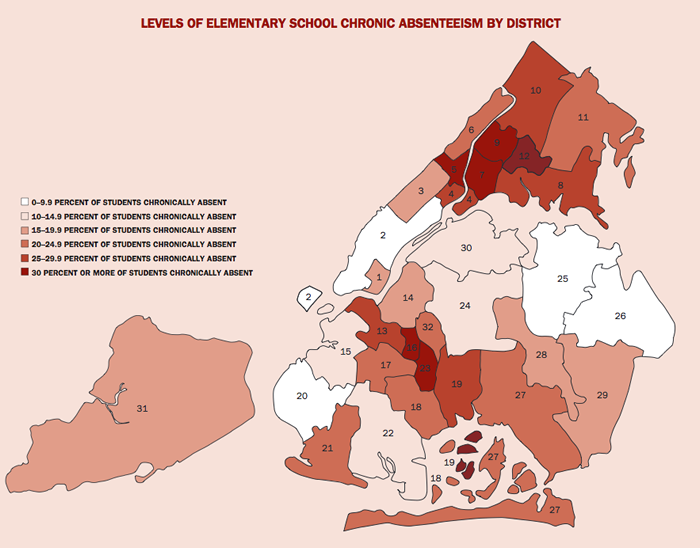New SCHOOL report: 87,000 NYC children K-5 miss at least one in every 10 days of school"A Better Picture of Poverty: What Chronic Absenteeism and Risk Load Reveal About NYC's Lowest-Income Elementary Schools" |
New York (November 6, 2014) - Children can’t learn if they aren’t in school. That should be obvious, but a new report by The Center for New York City Affairs at The New School shows that chronic absenteeism consigns tens of thousands of children to academic failure even before they leave elementary school. More than 87,000 New York City children in grades K-5 missed more than a month of school in 2012-13, according to the report, A Better Picture of Poverty: What Chronic Absenteeism and Risk Load Reveal About NYC’s Lowest-Income Elementary Schools. Improving attendance is critical to any strategy to improve struggling schools, the report says. The report, released at a panel discussion at The New School November 6, identifies 130 schools where more than one-third of the student body was chronically absent for five years in a row. Perhaps not surprisingly, these schools have very low levels of academic achievement as measured by standardized tests. Chronic absenteeism correlates with deep poverty—high rates of homelessness, child abuse reports, and male unemployment and low levels parental education. In fact, the report states, chronic absenteeism is a much better index of poverty than the traditional measure of the number of children eligible for free lunch. Moreover, it’s very hard for schools to escape the pull of poverty: only a handful of schools with above-average rates of chronic absenteeism had above-average pass rates on their standardized tests for math and reading—and most scored far below, the report states. The report identifies 18 “risk factors” that are associated with chronic absenteeism, both in the school building and in the surrounding neighborhood. Schools with a very high “risk load” are likely to suffer from poor attendance. Some of the school factors are: students in temporary housing; student suspensions; the perception of safety; and principal, teachers and student turnover. The neighborhood factors include: male unemployment, presence of public housing or a homeless shelter in a school’s attendance zone, adult levels of education, and involvement with the Administration for Children’s Services. The good news is that focused attention on improved attendance can make a big difference. In response to a 2008 report on chronic absenteeism by the Center, Mayor Bloomberg appointed an inter-agency task force to improve attendance in 100 schools. That work was successful—some schools were able to improve attendance quite a lot—but rates of chronic absenteeism remain high. The rate of chronic absenteeism in elementary schools declined from 23 percent in 2009 to 19 percent 2013. “Mayor de Blasio made the effects of poverty in school a major campaign issue. In his administration’s ongoing work, it is important to know which schools are facing the most virulent effects of poverty,” says Kim Nauer, lead author of the report and education research director at the Center. “Our work identifies those schools,” she says. “We argue that risk load and chronic absenteeism should be an important consideration as the mayor launches expensive new programs, like his promised 100 new community schools, explicitly designed to help students overcome poverty-related educational issues.” For more information, contact Kim Nauer at 646-942-8414 or at [email protected]. |
| Founded in 1919, The New School was born out of principles of academic freedom, tolerance, and experimentation. Committed to social engagement, The New School today remains in the vanguard of innovation in higher education, with more than 10,000 undergraduate and graduate students challenging the status quo in design and the social sciences, liberal arts, management, the arts, and media. The New School welcomes thousands of adult learners annually for continuing education courses and calendar of lectures, screenings, readings, and concerts. Through its online learning portals, research institutes, and international partnerships, The New School maintains a global presence. Learn more at www.newschool.edu. |
 |
MARKETING AND COMMUNICATION |
| 79 Fifth Avenue New York, NY 10003 www.newschool.edu |
PRESS RELEASE |
Media Contacts:
Kim Nauer |
|
|
